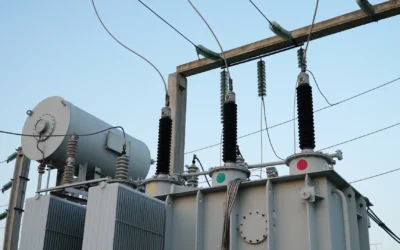• Power Technology Research expects that the global distribution transformer market will grow with a CAGR of 4.4% from 2022-2027.
• Key players in the global distribution market include Hitachi Energy, GE Electric, Siemens Energy, and Schneider Electric.
Since the last decade, especially after the Paris Agreement in 2015, the global energy market is observing a marked shift and is currently in a state of transition. This phenomenon of energy transition at a global level is impacting the power sector which in turn is affecting distribution transformer market as well. According to Power Technology Research, global market for distribution transformers is gaining momentum due to several key factors including increase in the demand of electricity, widespread deployment of renewable energy, replacement of aging infrastructure and government initiatives focused on improving reliability and stability of the electricity grid. It is significant to note that all these factors are influenced by the global energy transition.
Power Technology Research expects that the global distribution transformer market will grow with a CAGR of 4.4% from 2022-2027. Furthermore, key players in the global distribution market include Hitachi Energy, GE Electric, Siemens Energy, and Schneider Electric. It is noteworthy that the majority of the demand for distribution transformers originated from the Asia Pacific region accounting for 48% of the global demand in 2022. In terms of demand APAC was followed by North America accounting for 31% while rest of the demand was generated from EMEA and South America.

Figure 1: Key players in the global distribution market.
Source: Power Technology Research

Figure 2: Region-wise demand of distribution transformers.
Source: Power Technology Research
Need for Grid Modernization
As mentioned earlier that global energy market is undergoing a transition right now which has pushed utilities across the globe to modernize their electricity grid infrastructure. As per the assessment of Power Technology Research, decentralization, required improvements in energy efficiency and demand response are the key factors that will be driving the need for grid modernization in the near future.
Decentralization
Electricity grids are being decentralized which are in turn enabling widespread deployment of renewable energy sources. Renewable energy is an intermittent source of energy which requires support from the latest technologies to ensure reliable supply. It is noteworthy that decentralization has provided an opportunity to consumers to participate in the energy market as prosumers, which was otherwise not possible.
Required improvements in the energy efficiency
In pursuit of long-term climate goals economies have raised their targets for improvements in energy efficiency over the years. This has in turn pushed countries to modernize their electricity grids, as old technology is not capable of providing required improvements in energy efficiency. This is specifically the case with economies like EU member states and the US which can afford to invest in modern technologies.
Demand response
Demand response is an effective way to manage the consumption of electricity and in turn reduce the need to make capital investments in the electricity grid infrastructure including generation assets which are highly capital intensive. Optimized capital investments in the power sector are reflected in the basket price of electricity which is competitive. Furthermore, with the integration of renewables and EVs with the grid the need for demand response has risen drastically which is in turn positively impacting the demand for grid modernization.
Impact on legacy equipment
As electricity grids across the globe become more decentralized and distributed, it will create need for smaller, smarter, and flexible distribution transformers. These transformers would need to be equipped with sensors that collect real-time data and can predict peak demand in order to prevent overloading of the grid. This requirement has in turn pushed utility companies to opt for smart transformers instead of conventional transformers. If compared with conventional transformers, smart transformers offer a wide range of benefits, for instance higher flexibility, better monitoring and control, enhanced efficiency, and improved reliability.
Looking Forward
Power Technology Research believes that with the decentralization of grid followed by integration of distributed energy resources with the network, the need for smaller, flexible, and smart transformers has emerged. This in turn has pushed utilities across the globe, especially the utilities in the advanced economies to install smart transformers that provide greater flexibility, monitoring, control, efficiency, and reliability.
As per the estimates of Power Technology Research, distribution transformers (including smart distribution transformers) are expected to grow with a CAGR of 4.4% from 2022 to 2027. Power Technology Research has observed that the demand for smart transformers is on the rise and to address the rising demand transformer OEMs are investing in the development of smart transformer technology which involves integration of sensors, communication and automation systems with their products. Hitachi, Schneider Electric and Eaton are key transformer OEMs that have introduced smart transformer solutions. It is expected that in coming years transformer OEMs that offer smart products and solutions will be able to increase their market share in the global distribution transformer market as opposed to OEMs that offer only conventional solutions.
Distribution Transformers Service Overview
The research presented in this article is from PTR's Distribution Transformer service. For information about this service please submit a request shown below.
Contact Sales:
Europe
+49-89-12250950
Americas
+1 408-604-0522
Japan
+81-80-7808-1378
GCC/Rest of APAC
+971-58-1602441
More about our:
Distribution Transformers Market Research
Recent Insights
US Elections: Consequences of a Second Trump Presidency for Energy Sector
The US is making strides to move away from fossil fuels and eventually decarbonize the energy sector. The White House aims to achieve 80% renewable...
US Power Transformer Market Snapshot
US Power Transformer Market SnapshotMarket OverviewUSA to expand transmission systems by 60% by 2030 and may need to triple those systems by...
Sustainability Across Sectors: Highlights from GreenTech Festival 2024
Recently, I had the privilege to attend and present at the Greentech Festival, an excellent event in the realm of sustainability. This influential...


